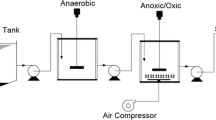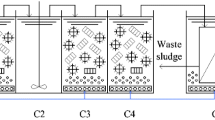Abstract
An anaerobic/aerobic moving-bed biofilm (A/O-MBBR) reactor system was constructed, and the treatment efficiency of aqueous antibiotics in wastewater was investigated. The effects of antibiotics on the microbial communities in the A/O-MBBR were also investigated. Under the optimized reaction conditions, removal of tetracycline antibiotics (TCs) was studied in a series of experiments. When a low concentration of tetracycline (TC) was added to the reactor system, high removal efficiency of conventional pollutants (TC concentration decreased from 10 turn to 2.8 μg L−1) was achieved. When mixed TCs (50 μg L−1) were added to the system, the removal efficiencies of chlortetracycline (CTC), TC and oxytetracycline (OTC) reached 52.03, 41.79, and 38.42%, respectively. TC degradation was decreased to 21.16% when the antibiotic concentration was 500 μg L−1; exposure to this TC concentration destroyed the community structure of the activated sludge bacteria in the reactor. The products of the biodegradation analysis revealed the possible degradation pathways functioning in the experimental A/O-MBBRs.






Similar content being viewed by others
References
Yang Y, Okb YS, Kimc KH, Kwond E, Tsanga YF (2017) Occurrences and removal of pharmaceuticals and personal care products (PPCPs) in drinking water and water/sewage treatment plants: a review. Sci Total Environ 596(15):303–320
Bui XT, Vo TPT, Ngo HH, Guo WS, NguyenT T (2016) Multicriteria assessment of advanced treatment technologies for micropollutants removal at large-scale applications. Sci Total Environ 563–564:1050–1067
Cazes MD, Abejon R, Belleville MP, Sanchez-Marcano J (2014) Membrane bioprocesses for pharmaceutical micropollutant removal from waters. Membranes 4:692–729
Archer E, Petrie B, Kasprzyk-Hordern B, Wolfaardt GM (2017) The fate of pharmaceuticals and personal care products (PPCPs), endocrine disrupting contaminants (EDCs), metabolites and illicit drugs in a WWTW and environmental waters. Chemosphere 174:437–446
Prabhasankar VP, Joshua DI, Balakrishna K (2016) Removal rates of antibiotics in four sewage treatment plants in South India. Environ Sci Pollut Res 23(9):8679–8685
Clellan KM, Halden RU (2010) Pharmaceuticals and personal care products in archived US biosolids from the 2001 EPA national sewage sludge survey. Water Res 44(2):658–668
Matsuia Y, Ozu T, Inoue T, Matsushia T (2008) Occurrence of a veterinary antibiotic in streams in a small catchment area with livestock farms. Desalination 226(1–3):216–221
Vieno NM, Hurkki H, Tuhkanen T, Kronberg L (2007) Occurrence of pharmaceuticals in river water and their elimination in a pilot scale drinking water treatment plant. Environ Sci Technol 41(14):5077–5084
Verma B, Headley JV, Robarts RD (2007) Behaviour and fate of tetracycline in river and wetland waters on the Canadian Northern Great Plains. J Environ Sci Health Part A 42(2):109–117
Yang SF, Lin CF, Wu CJ, Ng KK, Lin AY (2012) Fate of sulfonamide antibiotics in contact with activated sludge-sorption and biodegradation. Water Res 46(4):1301–1308
Khan MH, Bae H, Jungb JY (2010) Tetracycline degradation by ozonation in the aqueous phase: proposed degradation intermediates and pathway. J Hazard Mater 181(1–3):659–665
Aba-Guevara CG, Medina-Ramírez IE, Hernández-Ramírez A, Jáuregui-Rincón J, Lozano-Álvarez JA (2017) Comparison of two synthesis methods on the preparation of Fe, N–Co-doped TiO2 materials for degradation of pharmaceutical compounds under visible light. Ceram Int 43(6):5068–5079
Zekker I, Rikmann E, Kroon K, Mandel A, Mihkelson J, Tenno T, Tenno T (2017) Ameliorating nitrite inhibition in a low-temperature nitritation–anammox MBBR using bacterial intermediate nitric oxide. Int J Environ Sci Techol 15:1–15
Huang MH, Zhang W, Liu C, Hu HY (2015) Fate of trace tetracycline with resistant bacteria and resistance genes in an improved AAO wastewater treatment plant. Process Saf Environ Protect 93:68–74
Xia SQ, Jia RY, Feng F, Xie K, Li HX, Jing DF, Xu XT (2012) Eefect of solids retention time on antibiotics removal performance and microbial communities in an A/O-MBR process. Biores Technol 106(2):36–43
Shi YJ, Wang XH, Qi M, Diao H, Gao MM, Xing SF (2011) Sorption and biodegradation of tetracycline by nitrifying granules and the toxicity of tetracycline on granules. J Hazard Mater 191:103–109
Chiarello M, Minetto L, Giustina SVD, Beal LL, Moura S (2016) Popular pharmaceutical residues in hospital wastewater: quantification and qualification of degradation products by mass spectroscopy after treatment with membrane bioreactor [J]. Environ Sci Pollut Res 16:1–11
Song XY, Liu R, Chen LJ, Kawagishi T (2017) Comparative experiment on treating digested piggery wastewater with a biofilm MBR and conventional MBR: simultaneous removal of nitrogen and antibiotics. Front Environ Sci Eng 11(2):11–18
Aydin E, Şahin M, Taşkan E, Hasar H, Erdem M (2016) Chlortetracycline removal by using hydrogen based membrane biofilm reactor. J Hazard Mater 320:88–95
Tran NH, Chen H, Reinhard M, Mao F, Gin YH (2016) Occurrence and removal of multiple classes of antibiotics and antimicrobial agents in biological wastewater treatment processes. Water Res 104:461–472
Hosseini KE, Alavi Moghaddam MR, Hashemi SH (2011) Post-treatment of anaerobically degraded azo dye Acid Red 18 using aerobic moving bed biofilm process: enhanced removal of aromatic amines. J Hazard Mater 195(1):147–154
Plósz BG, Vogelsang C, Macrae K, Heiaas HH, Lopez A, Liltved H, Langford KH (2010) The BIOZO process—a biofilm system combined with ozonation: occurrence of xenobiotic organic micro-pollutants in and removal of polycyclic aromatic hydrocarbons and nitrogen from landfill leachate. Water Sci Technol 61(12):3188–3197
Kawan JA, Hasan HA, Suja F, Jaafar O, Abd-Rahman R (2016) A review on sewage treatment and polishing using moving bed bioreactor (MBBR). J Eng Sci Technol 11(8):1098–1120
Chen S, Sun D, Jong-Shik C (2007) Treatment of pesticide wastewater by moving-bed biofilm reactor combined with Fenton-coagulation pretreatment. J Hazard Mater 144:577–584
Jia RY, Jing DF, Li HX, Xie K, Huang TS, Zhang ZQ, Xu XT, Xia SQ (2011) Membrane bioreactor process for removing selected antibiotics from wastewater at different solids retention times. Fresenius Environ Bull 20(3a):754–763
Kovalova L, Siegrist H, Singer H, Wittmer A, McArdell CS (2012) Hospital wastewater treatment by membrane bioreactor: performance and efficiency for organic micropollutant elimination. Environ Sci Technol 46:1536–1545
Sombatsompop K (2011) A comparative study of sequencing batch rector and moving bed sequencing batch reactor for piggery wastewater treatment. Maejo Int J Sci Technol 5(02):191–203
Zekker I, Tenno T, Tenno T (2016) Step-Wise temperature decreasing cultivates a biofilm with high nitrogen removal rates at 9 °C in short-term anammox biofilm tests. Environ Technol 37(15):1933–1946
Daija L, Selberg A, Rikmann E, Zekker I, Tenno T, Tenno T (2016) The influence of lower temperature, influent fluctuations and long retention time on the performance of an upflow mode laboratory-scale septic tank. Desalin Water Treat 57(40):1–9
Xuan R, Arisi L, Wang Q, Yates SR, Biswas KC (2010) Hydrolysis and photolysis of oxytetracycline in aqueous solution. J Environ Sci Health Part B 45(1):73–78
Yang YD, Chen DH, Chen L (2010) Studies on characteristics of adsorption and biodegradation of typical PPCPs oxytetracycline in the activated sludge treatment system [J]. Technol Water Treat 36(5):66–69 (in Chinese)
Acknowledgements
The authors gratefully acknowledge the National Natural Science Foundation of China (Project no. 51008216) and the research fund for the Doctoral Program of Higher Education of China (31400347) for their financial support.
Author information
Authors and Affiliations
Corresponding author
Ethics declarations
Conflict of interest
The authors declare that they have no conflict of interest.
Rights and permissions
About this article
Cite this article
Chen, HY., Liu, YD. & Dong, B. Biodegradation of tetracycline antibiotics in A/O moving-bed biofilm reactor systems. Bioprocess Biosyst Eng 41, 47–56 (2018). https://doi.org/10.1007/s00449-017-1842-7
Received:
Accepted:
Published:
Issue Date:
DOI: https://doi.org/10.1007/s00449-017-1842-7




